
Minidoka Relocation Center, Idaho
 Map of the camp |
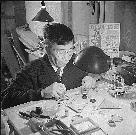
Watch repair shop. Sokichi Hoshide, head watch-maker., 12/10/1942 |
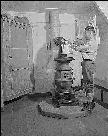
View in the home of Eizo Nishi. The pot bellied stove shown in this photo burns coal and provides ample heat. |
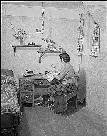
View in the home of Mrs. Eizo Nishi. This view shows attractive scene in which this evacuee family has decorated their barrack apartment. |

View in the home of Eizo Nishi, showing attractive way this evacuee family has decorated their barrack apartment. |

Free-hand drawing class, 12/09/1942 |
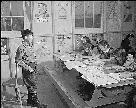
Tatsuo Matsuda (Model) Free-hand drawing class., 12/09/1942 |

Winter time panorama view, 12/09/1942 |

Community Store in block 30, 12/09/1942 |

Community store block 30. Customers warming hands by stove., 12/09/1942 |
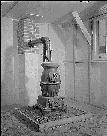
This picture shows coal stove which is furnished by War Relocation Authority., 12/09/1942 |

This picture shows other view of apartment. War Relocation Authority furnishes sleeping equipment, only other thing furnished is a light globe. |
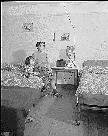
Mrs. Eizo Nishi, and Eime, four, daughter. All the furniture in this evacuee apartment was constructed from scrap material. The wall paper, drapes and other furnishings were purchased from a mail order house. |
 Crew of chefs preparing lunch under the direction of chef Dave K. Yoshida, formerly employed by Benjamin Franklin Hotel, Seattle, Washington. |
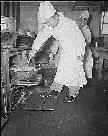 Kitchen crew preparing lunch. Menu: Baked macaroni with spanish sause, spinach, pickled beets, bread-pudding, tea, bread & butter. |
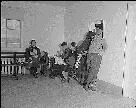
Hospital Series. Out patient waiting room., 12/10/1942 |
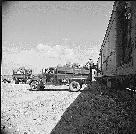
The baggage of approximately six hundred evacuees from the assembly center at Puyallup, Washington, is taken from the train by truck to their new homes at the Minidoka War Relocation Authority Center. |

Memorial |

Memorial |
 Memorial |
 Radio Repair Shop. Henry Tambora, Radio Repairman. Former occupation: radio repairman. Former residence: Portland, Oregon
|
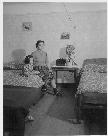 All the furniture in this evacuee apartment was constructed from scrap material. The wall paper, drapes and other furnishings were purchased from a mail order house. (L to R) Mrs. Eizo Nishi, housewife, and Eime, four, daughter. Former residence: Seattle, Washington. 12/9/43 |
 Eden, Idaho--A panorama view of the Minidoka War Relocation Authority center. This view, taken from the top of the water tower at the east end of the camp, shows partially completed barracks. 8/18/42
|
 Main administration building. Hunt, Idaho. |
 Joseph Gerald Osamu Sakamoto, 80, and Mary Ann Tsuchi Sakamoto, 80, on their golden wedding anniversary. Mr. and Mrs. Sakamoto came to the United States from Japan in 1894. He was the first Japanese second-hand furniture store proprietor, first Japanese express man and one of the first vegetable market operators in Seattle.. 12/11/43
|
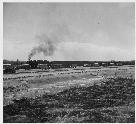 A train bringing approximately six hundred evacuees from the assembly center at Puyallup, Washington. Busses, used to transport these people to the Minidoka War Relocation Authority center, are waiting at the siding. 8/17/42 |
 T/4 Taniguchi visits his wife and daughter at the Minidoka Relocation Center before returning to his unit in the Pacific. Taniguchi volunteered for the Army in 1942 when he and his family were at Tule Lake before it became a segregation center. He served in the China-Burma-India theatre and served on loan to General Wingate's Chindits, a British unit fighting in the Burma Jungles often behind Japanese lines. |
 Baggage, belonging to evacuees who have just arrived from the assembly center at Puyallup, Washington, is sorted and trucked to barrack apartments. 8/17/42 |
 Shown here are the four Sakura brothers who have volunteered for service in the combat team in the United States Army which is composed of Americans of Japanese ancestry. These four brothers are fulfilling a vow made to their father, who died 20 years ago, to live and die for the United States, if Japan and America should ever go to war. (Left to right): Lt. Stanley D. Arnold, head of the War Department Recruiting Team, and the four Sakura brothers, Ken, Chester, Ted and Howard. 3/26/43
|
 Fumi Onodera, 20, proudly points at the names of her 3 brothers, Ko, Kaun, 24; and Satoru, 22, on the Honor Roll of Japanese Americans serving in the U. S. Army from the Minidoka Relocation Center, Hunt, Idaho. The 3 brothers are in training in a combat team at Camp Shelby, Mississippi, with other Americans of Japanese parentage. Some have already seen action in Italy. The Onodera brothers are the sons of Mr. and Mrs. Toyosuke Onodera of Hunt. He was formerly a tailor in Seattle, Washington. The Hunt Honor Roll numbers 416 now and the list is still growing. More than half volunteered since Pearl Harbor. 10/14/43 |
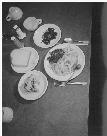 Luncheon serving ....... Menu: Baked macaroni with Spanish sauce, spinach, pickled beets, bread pudding, tea, bread and butter. 12/2/42 |
Although there have been many books written about the Japanese-American internment, only some of them even mention the newsletters produced at the camps and, at most, they generally will have only one or two pages from one of the issues.
This is leaving out one of the most historically interesting and important aspects of the internment. The newsletters that were produced give the day-to-day news of interest to the community of those who were interned. I am sure that there were restraints on what the newsletters were allowed to print, but they still tend to contain a wealth of interesting material.
I ran across one particularly valuable source, Densho . They have a vast number of the newsletters. I found a few elsewhere.
This particular newsletter had a couple of incarnations. First was the Denson Communique, which ran around forty issues. Then came the Denson Tribune, which ran over 140 issues.
Volume 1 #1-5
Volume 1 #6-10
Volume 1 #11-15
Volume 1 #16-20
Volume 1 #21-25
Volume 1 #26-30
Volume 2 #1-5
Volume 2 #6-10
Volume 2 #11-15
Volume 3 #1-5
Volume 3 #6-10
Volume 3 #11-15
Volume 3 #16-20
Volume 3 #21-25
Volume 3 #26-30
Volume 3 #31-35
Volume 3 #36-40
Volume 3 #41-45
Volume 3 #46-52
Volume 4 #1-5
Volume 4 #6-10
Volume 4 #11-15
Volume 4 #16-20
Volume 4 #21-25
Volume 4 #26-30
Volume 4 #31-35
Special Edition Feb. 3, 1943
Special Edition Feb. 3, 1943
Volume 4 #36-40
Volume 4 #41-45
Volume 4 #46-52
Volume 5 #1-5
Volume 5 #6-10
Volume 5 #11-15
Volume 5 #16-22
Extra, Jan. 29, 1943
Main Index
Japan main page
Japanese-American Internment Camps index page
Japan and World War II index page
|
|